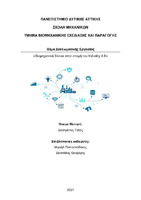Βιομηχανικά δίκτυα στην εποχή του Industry 4.0
Industrial networks in the era of Industry 4.0

Keywords
Βιομηχανική επανάσταση ; Industry 4.0 ; Βιομηχανία ; IoT ; Διαδίκτυο πραγμάτων ; Internet of things ; Κυβερνοφυσικά συστήματα ; Industrial internet of things ; IIoT ; Τεχνητή νοημοσύνη ; MQTT ; PLC ; Προγραμματιζόμενοι λογικοί ελεγκτές ; Cloud ; SCADA ; Cyberphysical systems ; Αυτοματισμός ; OPC Foundation ; Open Platform Communications ; OPC UA ; QoS ; Quality of service ; Ποιότητα υπηρεσιών ; Remote terminal unit ; RTU ; Human-Machine Interface ; HMI ; Πρωτόκολλα ; Servers ; Δίκτυα ; TCP ; Master terminal unit ; MTUAbstract
Η παρούσα διπλωματική εργασία ασχολείται με έννοιες που σχετίζονται με την 4η βιομηχανική επανάσταση ή αλλιώς Industry 4.0. Στο κεφάλαιο 1 γίνεται εισαγωγή του όρου Industry 4.0, παρουσιάζονται τα κύρια οφέλη του και μερικές από τις προκλήσεις
που προκύπτουν. Στη συνέχεια, γίνεται ανάλυση του όρου IoT και των εφαρμογών του, της αρχιτεκτονικής του, καθώς και της επίδρασής του πάνω στη βιομηχανία. Στο κεφάλαιο 2 αναλύονται σε βάθος οι προγραμματιζόμενοι λογικοί ελεγκτές (PLCs) και
τα συστήματα SCADA. Μερικές σημαντικές ενότητες του κεφαλαίου είναι τα δομικά μέρη ενός PLC, τα βασικά στοιχεία ενός συστήματος SCADA και η αρχιτεκτονική ενός συστήματος SCADA. Στο κεφάλαιο 3 γίνεται παρουσίαση του πρωτοκόλλου
επικοινωνίας MQTT. Συγκεκριμένα, αναλύεται το πρότυπο pub/sub, η δομή των MQTT πακέτων και μερικά επιπλέον βασικά στοιχεία του πρωτοκόλλου. Τέλος, στο κεφάλαιο 4 εισάγεται το πρότυπο OPC UA. Αρχικά αναφέρεται ξεχωριστά το OPC
Foundation και στη συνέχεια η ιστορική αναδρομή του OPC UA. Επίσης, αναφέρεται και η σύνδεση του OPC UA με το Industry 4.0. Στη συνέχεια, αναλύεται η αρχιτεκτονική του καθώς και κάποια πλεονεκτήματα και μειονεκτήματα.
Abstract
The following thesis deals with concepts related to the 4th Industrial Revolution or Industry 4.0. Chapter 1 introduces the term Industry 4.0, presents its main benefits and some of the challenges that arise. Next, an analysis of the term IoT and its applications, its architecture, and its impact on industry is given. Chapter 2 provides an in-depth analysis of Programmed Logic Controllers (PLCs) and SCADA systems. Some important sections of the chapter are the building blocks of a PLC, the basic elements of a SCADA system and the architecture of a SCADA system. Chapter 3 presents the MQTT communication protocol. Specifically, the pub/sub standard, the structure of the MQTT packages and some additional key elements of the protocol are analyzed. Finally, Chapter 4 introduces the OPC UA standard. It first refers separately to the OPC Foundation and then to the historical review of the OPC UA. The connection of OPC UA with Industry 4.0 is also mentioned. Then, its architecture is analyzed as well as some advantages and disadvantages.

